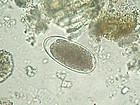| This article is still under construction. |
The life cycle of a trichostrongyloidea are direct, and infection is through ingestion of L3. They are a bursate group, with Dictyocaulus forming the only exception. Important genera include Ostertagia, Haemonchus and Trichostrongylus.
General Life-Cycle
The egg is approximately 80µm long, oval, thin-shelled, and containing 4-16 cells, so is a typical strongyle egg.
Egg → L1 → L2 → L3 occurs on the ground. L1 and L2 feed on bacteria, and L3 is exsheathed and represents the infective stage. L3 cannot feed, but do contain a finite amount of stored food to provide energy for movement. Infection is via ingestion of the L3. L3 → L4 → adult, these stages generally occur in the stomach or small intestine.
Parasitic development initially occurs in gastric glands or intestinal crypts, species dependent. Adults are generally found on the mucosal surface, and the prepatent period is typically about 3 weeks.
